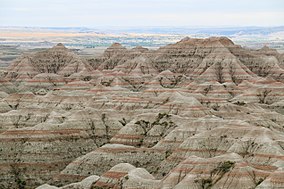
Back حديقة بادلاندز الوطنية Arabic Taman Nasional Badlands BAN Бедлендс (национален парк) Bulgarian Parc Nacional de les Badlands Catalan Badlands National Park CEB Národní park Badlands Czech Badlands National Park Danish Badlands-Nationalpark German Parque nacional Badlands Spanish Badlandsi rahvuspark Estonian
| Badlands National Park | |
|---|---|
 Badlands National Park | |
| Location | South Dakota, United States |
| Nearest city | Rapid City, South Dakota |
| Coordinates | 43°45′N 102°30′W / 43.750°N 102.500°W |
| Area | 242,756 acres (982.40 km2)[1] |
| Established | January 25, 1939 as a National Monument November 10, 1978 as a National Park |
| Visitors | 1,006,809 (in 2022)[2] |
| Governing body | National Park Service |
| Website | Badlands National Park |
  |
| Southwestern South Dakota |
|---|
| Sculptures |
| Geologic and natural history |
| Mountains |
| Caves |
| Forests and wildernesses |
| Lakes |
| Scenic byways |
| Historic sites |
Badlands National Park (Lakota: Makȟóšiča[3]) is an American national park in southwestern South Dakota. The park protects 242,756 acres (379.3 sq mi; 982.4 km2)[1] of sharply eroded buttes and pinnacles, along with the largest undisturbed mixed grass prairie in the United States. The National Park Service manages the park, with the South Unit being co-managed with the Oglala Lakota tribe.[4]
Located within the White River drainage, the Badlands Wilderness protects 64,144 acres (100.2 sq mi; 259.6 km2) of the park's North Unit as a designated wilderness area,[5] and is one site where the black-footed ferret, one of the most endangered mammals in the world, was reintroduced to the wild.[6] The South Unit, or Stronghold District,[4] includes sites of 1890s Ghost Dances,[7] a former United States Air Force bomb and gunnery range,[8] and Red Shirt Table, the park's highest point at 3,340 feet (1,020 m).[9]
Authorized as Badlands National Monument on March 4, 1929, it was not established until January 25, 1939. Badlands was redesignated a national park on November 10, 1978.[10] Under the Mission 66 plan, the Ben Reifel Visitor Center was constructed for the monument in 1957–58. The park also administers the nearby Minuteman Missile National Historic Site. The movies Dances with Wolves (1990) and Thunderheart (1992) were partially filmed in Badlands National Park.[11]
This national park was originally a reservation of the Oglala Sioux Indians and spans the southern unit of the park. The area around Stronghold Table was originally Sioux territory, and is revered as a ceremonial sacred site rather than a place to live.
In 1868, at the Second Treaty of Fort Laramie, the United States assured the Sioux that the Badlands shall forever be the property of the Sioux. In 1889, however, the treaty was broken and the Badlands were confiscated by the United States.
At the end of the 19th century, the Sioux Indians used this area as the site of the Ghost Dance, a ceremony to revive the souls of buffalo and the dead. After the last ghost dance in 1890, the United States banned the ritual, but it was revived by the Red Power movement, a movement to restore Indian rights that began in the 1960s.[12][13] In 1980, the U.S. Supreme Court awarded compensation to the Sioux for the abrogation of the 1868 treaty, but the Sioux did not accept the money.[14][15]
- ^ a b "Listing of acreage – December 31, 2011" (XLSX). Land Resource Division, National Park Service. Retrieved March 5, 2012. (National Park Service Acreage Reports)
- ^ "NPS Annual Recreation Visits Report". National Park Service. Retrieved July 26, 2023.
- ^ Ullrich, Jan, ed. (2011). New Lakota Dictionary (2nd ed.). Bloomington, IN: Lakota Language Consortium. p. 855. ISBN 978-0-9761082-9-0. LCCN 2008922508.
- ^ a b "Badlands Visitor Guide: The official newspaper of Badlands National Park" (PDF). National Park Service. 2016. Retrieved July 25, 2016.
- ^ "Badlands Wilderness". Wilderness.net. Retrieved March 5, 2012.
- ^ "Badlands Visitor Guide" (PDF). National Park Service. 2008. p. 2. Retrieved March 12, 2011.
- ^ "Badlands National Park". Rand McNally. Archived from the original on February 25, 2011. Retrieved March 12, 2011.
The cultural centerpiece of this section is the Stronghold Table, where the Oglala Sioux danced the Ghost Dance for the last time in 1890.
- ^ "Pine Ridge Gunnery Range/Badlands Bombing Range". South Dakota Department of Environment & Natural Resources. Archived from the original on March 9, 2011. Retrieved March 12, 2011.
- ^ "U.S. National Park High Points". Peakbagger.com. Retrieved March 17, 2008.
- ^ "The National Parks: Index 2009–2011". National Park Service. Archived from the original on July 10, 2012. Retrieved March 5, 2012.
- ^ Maddrey, Joseph (2016). The Quick, the Dead and the Revived: The Many Lives of the Western Film. McFarland. Page 184. ISBN 9781476625492.
- ^ "Wounded Knee Massacre & The Ghost Dance (article)". Khan Academy. Retrieved May 16, 2021.
- ^ "The Convenient Falsehoods We're Taught about Native American History". Edge Effects. September 5, 2017. Retrieved May 16, 2021.
- ^ Frommer, Frederic J. (August 19, 2001). "Black Hills Are Beyond Price to Sioux". Los Angeles Times. Retrieved December 12, 2021.
- ^ Streshinsky, Maria (February 9, 2011). "Saying No to $1 Billion". The Atlantic. Retrieved May 16, 2021.
© MMXXIII Rich X Search. We shall prevail. All rights reserved. Rich X Search

